Please use the following link to download the June 19, 2021 issue of the syəcəb

syəcəb
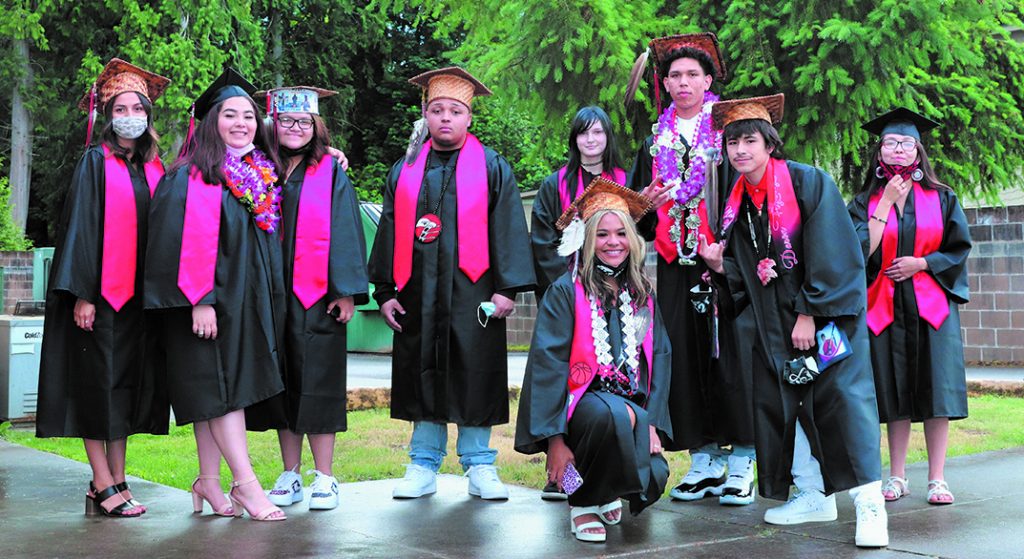
By Micheal Rios, Tulalip News
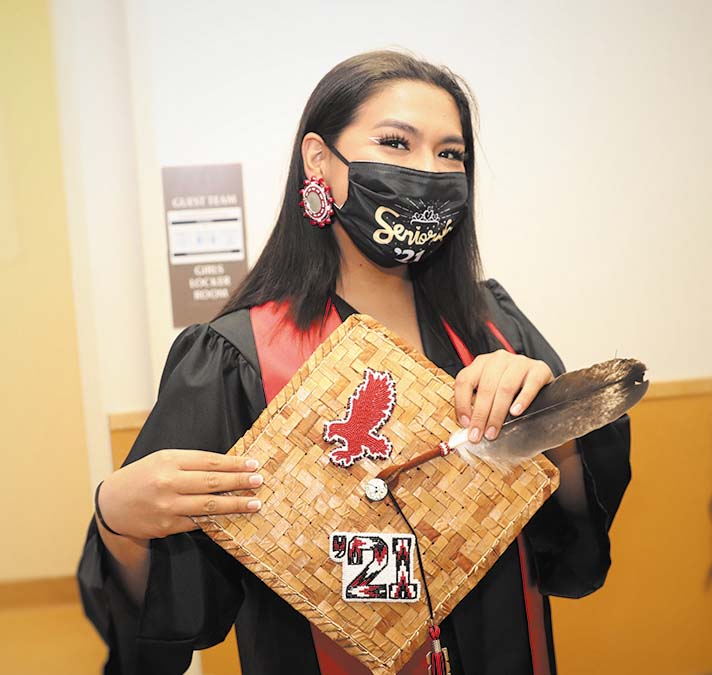
Dreams came true, legacies were continued, and history was rewritten on June 11 as thirty-one graduating seniors received their well-deserved diplomas at Tulalip Heritage’s high school commencement. Thirteen years of dedicated K-12 schooling came to fruition in an astonishing way for Heritage’s class of 2021 – the most graduates ever in a single academic year.
This particular group of graduates overcame a global pandemic, untold personal hardships, and a litany of other difficulties that came with a senior year unlike any other. Their determination to accumulate the twenty-four academic credits necessary to complete high school was bolstered in large part to by their steadfast support system at home and in the classroom.
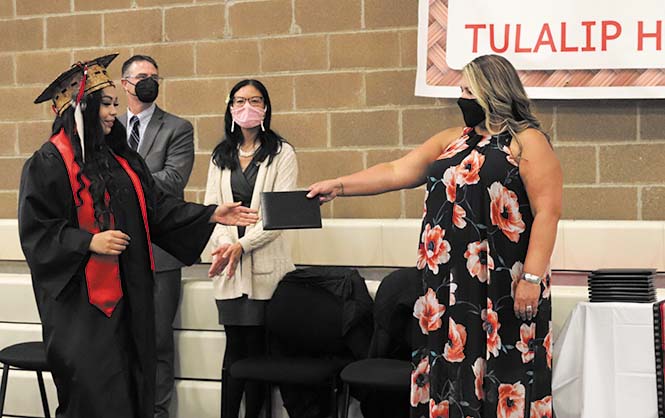
“These thirty-one graduates earned their way here through hard work, commitment and perseverance,” explained Principal Kelli Miller. “This was not the senior year we planned and certainly not the one we hoped for. Maybe they needed additional support, extra do-overs, a gentle push or a nagging phone call, but nevertheless they did what was necessary to reach their graduation goal and they deserve a huge congratulations for that. They didn’t get here because of Covid, they got here in spite of Covid. I couldn’t be more proud of this graduating class.
“Thank you to the family, friends and countless community members who have walked this journey with our graduating seniors,” she continued. “I congratulate each of you because I know these students wouldn’t be here today without the time and energy you all invested in them. Most importantly, thank you for trusting us with your children. It’s truly the highest honor and greatest gift that you can give us educators is the trust to educate and guide your children.”
The thirty-one seniors rewrote the history books not just for managing to prioritize their schoolwork during a pandemic, but also for being the largest Tulalip Heritage High School graduating class ever. One after another the students, adorned with ceremonial garb like intricately woven Cedar caps and beaded medallions, proudly strutted across Francy J. Sheldon gymnasium for the last time to accept their coveted diploma. In doing so, they were fulfilling the legacy of the gym’s namesake.
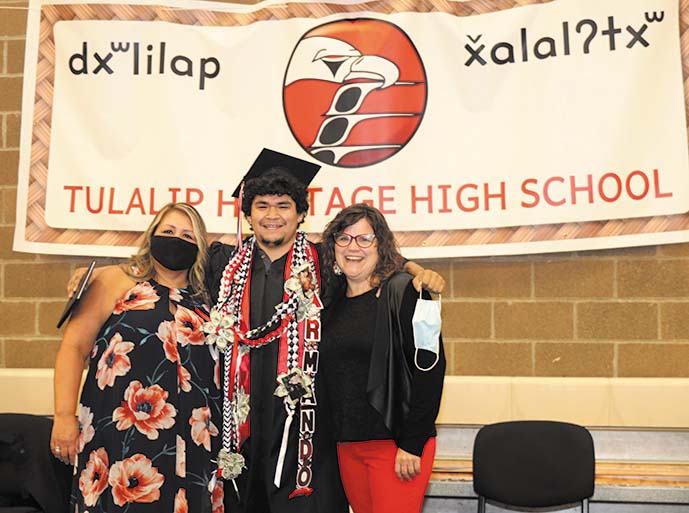
Sheldon, who passed away in 2002, was a revered leader best known for his life’s mission to create opportunities for Native youth to excel in school and sports. According to his family, he wanted Tulalip children to always strive to be better and be given agency to fully embrace their culture. Even though he was not physically present to witness the historical Heritage commencement, there’s no doubt he was there in spirit.
“Francy dreamed of having a school on the reservation where our children could get a quality education and learn their culture,” said his wife of forty-three years, Anita ‘Keeta’ Sheldon. “He’d be so proud of these graduates for completing their high school education in Tulalip, and in the process bettering themselves, their families and our society. Seeing the kids wearing their Cedar caps, he’d have loved that.”
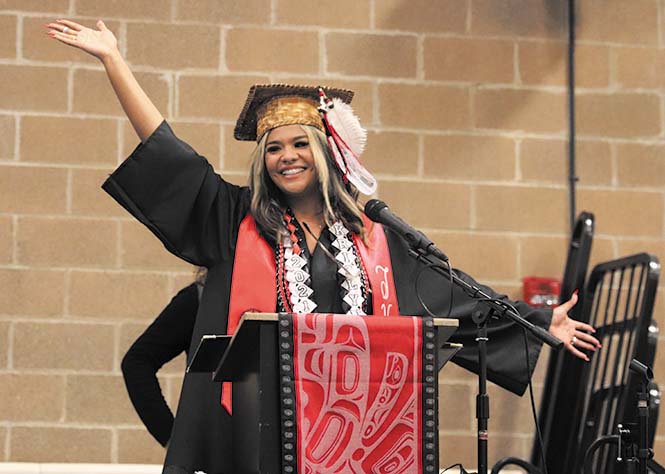
The end of high school usually means the end of free public education and free food. It’s the end of sleeping in all summer and, for some, the end of living at home. Receiving a diploma signifies the beginning of adulthood. It’s the beginning of true independence. It’s the beginning of finding a career, finding a place to live and perhaps pursuing additional education. The future is now full of possibility and wonder for Heritage’s latest graduates.
“This is the day we’ve all been waiting for since our first day of Kindergarten,” shared class representative and student speaker Krislyn Parks. “We, the graduating class of 2021, want to give a special thanks to all the teachers that have helped us every step the way, even when we were too stubborn or hardheaded to accept it. You all never gave up on us and words can’t explain how much we appreciate you because of that. Heritage is our home away from home. The teachers, office staff, lunch ladies, coaches and custodial workers took care of us in our best and worst moments. You all guided us, educated us, and showed us how to work together despite our differences, just like a loving family.
“Being a Heritage Hawk has changed my life forever,” she added. “Everyone at Heritage is my family and all my fellow classmates hold a special place in my heart. Now, as I stand here thinking about the past four years, I’m already viewing my high school experience differently. I may not remember all the class periods and homework assignments nor the answers to every test, but I know we will always remember the amazing memories and friendships that we’ve made. We can always draw strength from knowing Heritage will always be our home. Whatever we do and wherever we go, we will always be Heritage Hawks!”
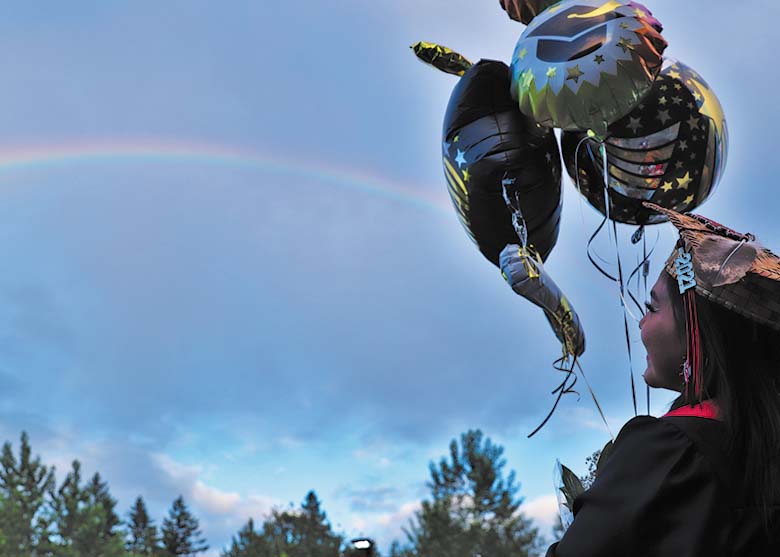
A roaring applause erupted when Krislyn instructed her classmates to move their tassels from right to left, indicating graduation. Upon exiting their home away from home, a stunning rainbow greeted them. The future is bright in Tulalip.
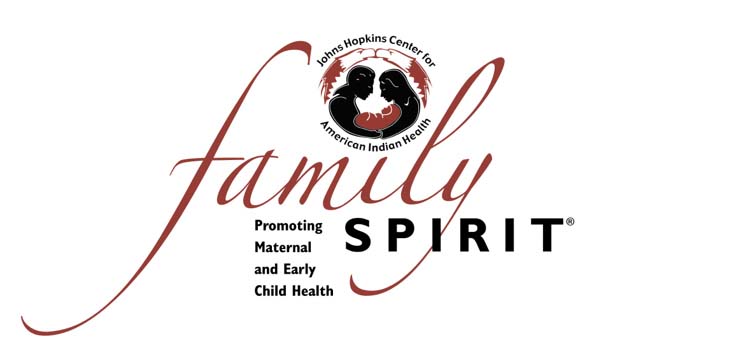
By Kalvin Valdillez, Tulalip News
If you are an expectant mother, first time parent or part of a blossoming family with children under the age of three, Tulalip Family Haven wants to hear from you.
Throughout the years, the department has assisted Tulalip tribal members, the community, and members of other tribal nations by developing programs that cater to local youth, parents, and families.
Through these programs, such as teen outreach, life skills, and a number of family-based programs, Family Haven provides their clients with educational tools and resources while building a space where the people they service can support and relate to one another, offer tips from personal experience, or simply lend a listening-ear to others in-need.
No matter the program, Family Haven has made it their priority to ensure that their families, from birth to parenthood, are on-track and in the best position to meet their personal short and long-term goals. By providing all the necessary tools and support, Family Haven designed each of their programs to empower tribal youth and families.
Keeping true to that successful formula, the department is introducing a new course to Tulalip. And they are doing it in a unique and fun way to engage people right off the bat and build a connection with local parents to better serve their needs.
“We’re officially launching Family Spirit,” said Sasha Smith, Family and Youth Support Coordinator for Family Haven. “We are accepting clients and want to get the word out. It has been really successful in other tribal communities and it’s evidenced-based, which is pretty hard to come by. It’s one of the very few.”
Tulalip News has the inside scoop on what the new program is and the specifics of everything that it entails. However, we will refrain from releasing this information just yet, at least until after June 25, when the winners of the Family Spirit promotional raffle are announced.
Sasha shared, “For one-week people can call-in, ask questions and get familiar with the program and in turn they will be entered into the drawing. We bought fun raffle prizes for those that call-in and we’ll close it on June 25, and deliver the prizes that week. We would like to gain that relationship, get to know you and listen to your needs and wants as parents.”
Prizes include an InstaPot pressure cooker, a Safety 1st Grow and Go 3-in-1 car seat, and a summertime gift bundle that contains sidewalk chalk, bubble wands and a full-sized Radio Flyer wagon.
“The biggest thing is having that personal connection and creating an opportunity to really talk,” Sasha stated. “Because what happens when people call-in and ask about the program, I get to understand a little bit more about them. We want to raise awareness to the community about [Family Spirit] and make sure that we are sharing those resources with them. If you or someone you know is pregnant, if you have little ones under the age of three, or if you just want to learn more about parenting, call us on up!”
To learn more about Family Spirit and to be entered into the giveaway, please contact Family Haven at (360) 716-4402.
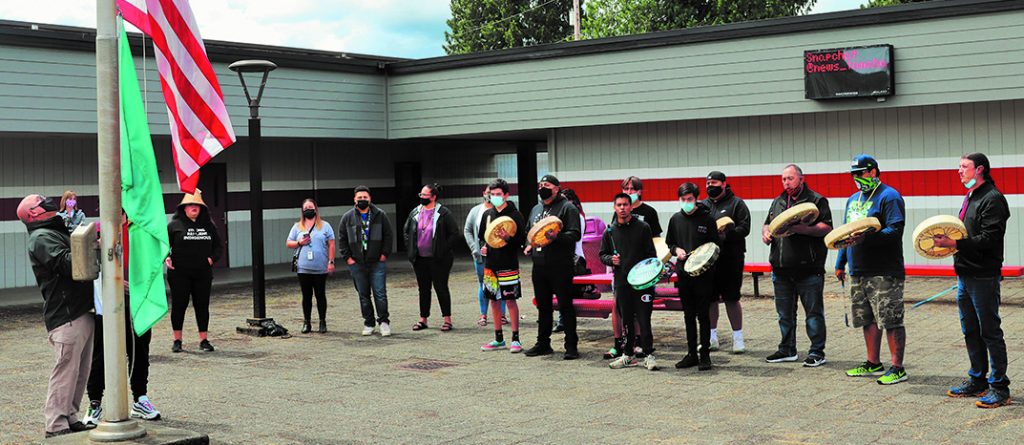
By Micheal Rios, Tulalip News
For quite possibly the first time ever, the red, white and black colors of the Tulalip Tribes are flying overhead at Marysville Pilchuck High School. Tulalip’s iconic orca was raised up on June 7 by tribal member and student representative Desmond Valencia during a celebratory gathering of M.P. students and staff, as well as a coalition of Native representatives with drum-in-hand.
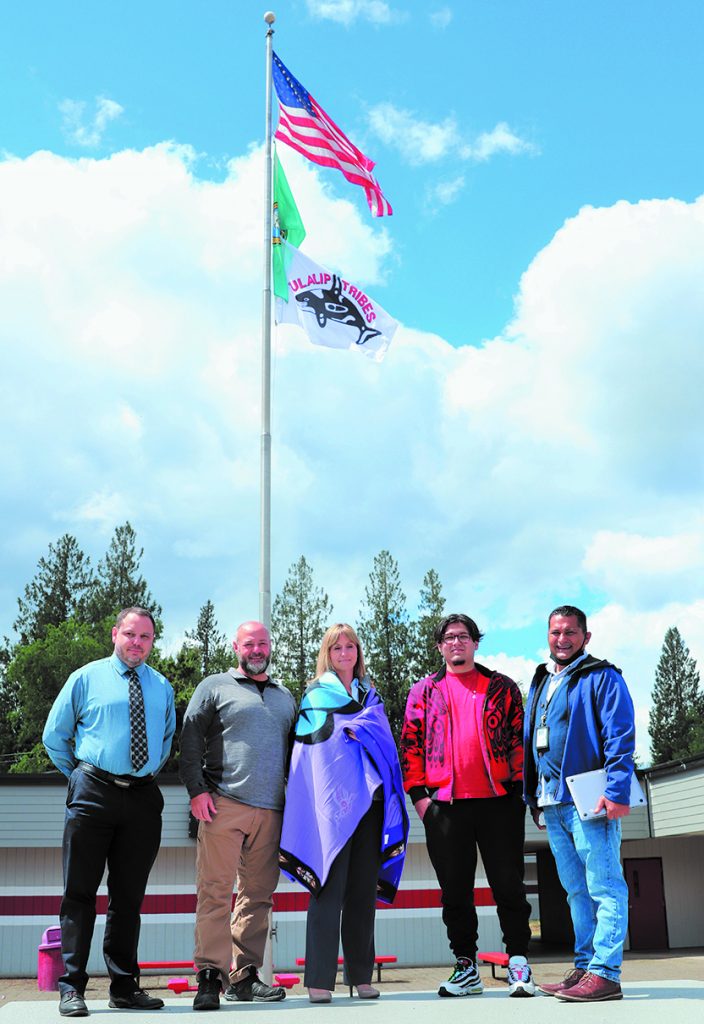
“The moment was surreal and there’s really no words to describe it,” said Desmond after he raised the flag to a traditional drum beat. “I was super nervous, but stepped out of my comfort zone to seize the opportunity to represent my people and my family. It’s a huge honor to be the first person to raise the flag and it felt good to see it flying as I walked to class today. It was definitely a good day to be Native.”
It’s no secret that Marysville and Tulalip have a history rife with conflict and misunderstanding, especially when it comes to the subject of education. However, raising the Tulalip flag is a symbol of hope for the future. It’s an action that intends to create a better partnership between the two communities.
“ This is a step in the right direction,” declared cultural specialist Chelsea Craig as the gathering’s first speaker. “Marysville and Tulalip, we are one community. We stand on the traditional lands of the Snohomish people right now, and by raising this flag we are healing the story of education for our community.”
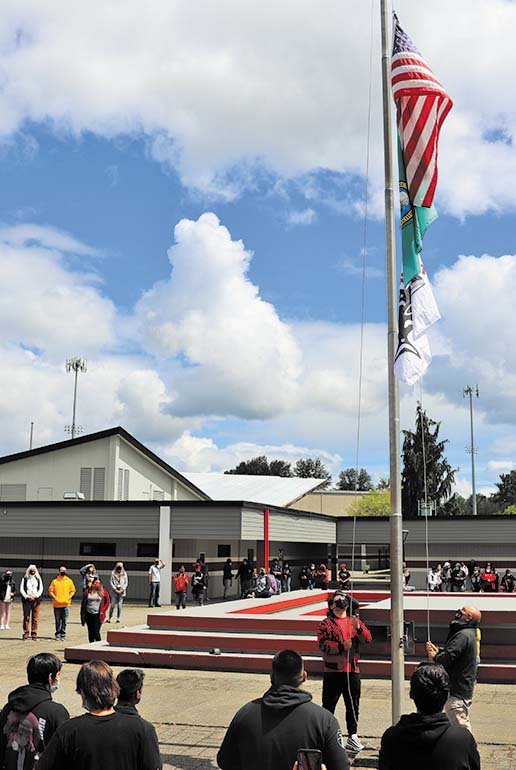
Principal Christine Bell made it a mission of hers to make this day happen. Seeing this united effort through from start to finish, in collaboration with Native advocate Doug Salinas and Native liaison Matt Remle, allows a more diverse student body to feel accepted and proudly celebrate their culture.
“It’s very important to me as a principal that all of our students see themselves in their school and for as long as I’ve been here we’ve worked hard to make it that way,” shared Principal Bell. “My thanks go out to the Tulalip Tribes for allowing this to happen. We share a desire to have our students feel accepted for who they are. School culture is what you celebrate and choose to reinforce. If we’re not celebrating our Tulalip students, then we are doing this wrong.”
For all Principal Bell has done to uplift Tulalip students and culture during her M.P. tenure she was blanketed in true Native fashion.
“What a blessing to be honored and blanketed in that way. It means the world to me to be able to make this flag raising happen. This is a day I won’t ever forget,” she said. She also announced that in addition to the flag at the entrance of the school, there will be two more used for display during school events.
Among the crowd of event observers was a beaming Tulalip tribal member, 18-year-old Martelle Richwine.
“As a former Tomahawk, it warms my heart to see Marysville Pilchuck open their eyes to our Native community,” said the class of 2021 graduate. “When I was a student I felt that I wouldn’t be accepted as a Native American, but to know that M.P. now cares means the world because current and incoming Native students can feel comfortable in their own skin.”
“After this defining moment, I believe that the Marysville/Tulalip partnership can only go up from here,” added Desmond, a fellow graduating senior who plans on attending WSU in the fall. “One of my goals is to get more involved in tribal events and do my part in bettering our community. After I finish college, I would definitely love to come back and continue to see the relationship thrive.”
By adding the Tulalip flag to the same pole that holds the United States and Washington State flags, Marysville Pilchuck recognizes Tulalip’s sovereignty as an Indigenous nation and acknowledges that the best way forward is in partnership, one step at a time.
May 4, 1959 – June 7, 2021
Carolyn Rose Moses (Setlakus/Lalacut) was born May 4, 1959 in Powell River, B.C. She was a descendant of Hereditary Chief Johnny Dominick of Klahoose Nation, B.C., and Hereditary Chief Charles Jules of Tulalip. Daughter of William Grenier Jr. (Gladys Grenier) and Elizabeth Harry (Pete Harry). Carolyn spent her childhood years in Sliammon Territory but settled in Tulalip where she married her soul mate Kenneth Moses Jr. on July 16, 1983. Carolyn and Kenneth were married for 28 years and raised two children together, Craig Grenier Moses and Autumnrose Moses.
Carolyn was a residential school survivor and a true warrior for her people. She was a proud Coast Salish woman and spent her life in service to her people. She began in the kitchen cooking for tribal elders, then transferred over to family services where she spent over 20 years helping members of the community. Carolyn advocated for women, children, worked tirelessly helping many people find sobriety, and helped many in their journey along the red road. She wanted people to feel good about themselves and was often heard encouraging someone. She would say “I’m proud of you…you’re doing good.” Carolyn believed in her teachings and had a gift for knowing everyone. She could name every tribal member’s family and many of their relatives going back several generations. She spent 16 years serving on the enrollment committee and used her gifts to help enroll many tribal members and their relatives.
Carolyn had a infectious laugh and a joyful presence that could not be denied and she lit up the room when she walked in. She enjoyed traveling, shopping and lunch with her friends.
Carolyn is survived by her brothers, Murray (Nancy) Mitchell, Leonard (Cathy) Harry, Darryl Wilson, and Laurie (Teresa) Harry; sisters Lillian (Rob) Grenier, Tina (Patrick) Grenier, Toni (Arthur) Grenier, and Sandra (Stan) Harry; and her two children Craig (Florence) Grenier Moses, and Autumnrose (Anthony Enriqurez) Moses. She had eleven grandchildren, Kaeli, Garrett, Gracelyn, Ethan, Liam, Mayah, Cid, Amilio, Benny, James, and Carlos. She was loved by many and was a grandmother, aunt and cousin to numerous individuals in the community.
Funeral Services will be held Saturday, June 12, 2021 at 10:00 AM at the Tulalip Gathering Hall with burial to follow at Mission Beach Cemetery. Arrangements entrusted to Schaefer-Shipman Funeral Home.
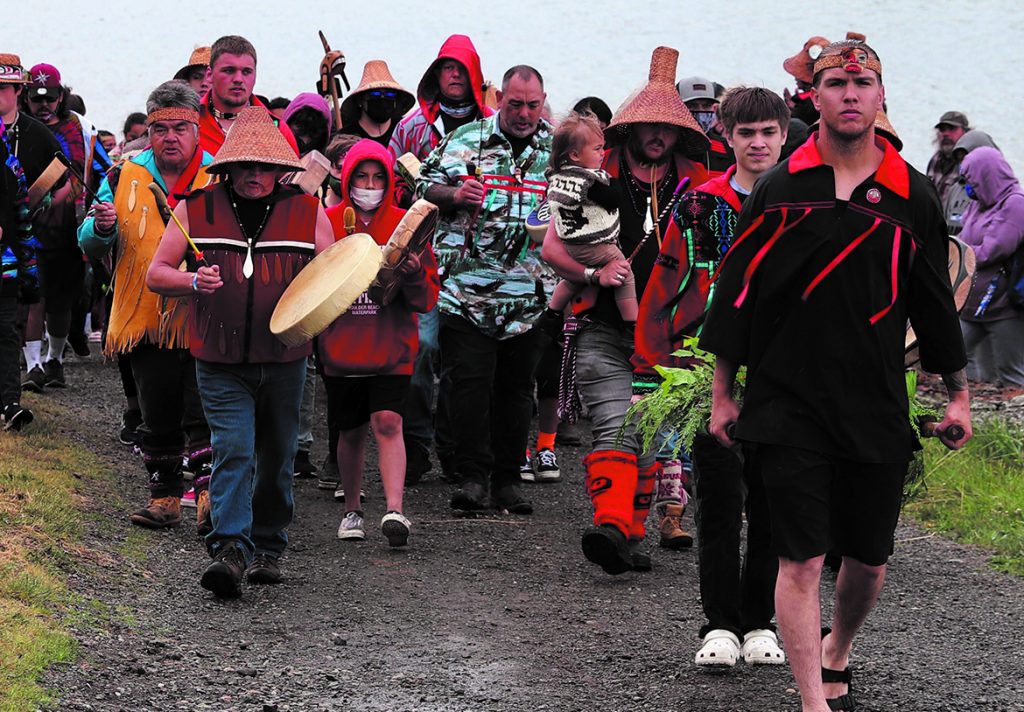
Honoring King Salmon
By Kalvin Valdillez, Tulalip News
Last year, for the first time in over four decades, the Tulalip Tribes made the difficult decision to cancel the Salmon Ceremony to help limit the spread of COVID-19 at the height of the worldwide pandemic. During the yearly event, not only does the Tribe pay respect to the entire salmon species but they also provide the tribal fishermen with a blessing for a plentiful and safe season out on the water, while also sharing good traditional medicine along the way.
After nearly two calendar years, smoke billowed once again from the longhouse overlooking Tulalip Bay on the morning of June 5, as Tulalips gathered in traditional regalia to immerse themselves into their culture, practice the teachings of their ancestors and most importantly recognize, honor and celebrate yubəč, the king salmon.
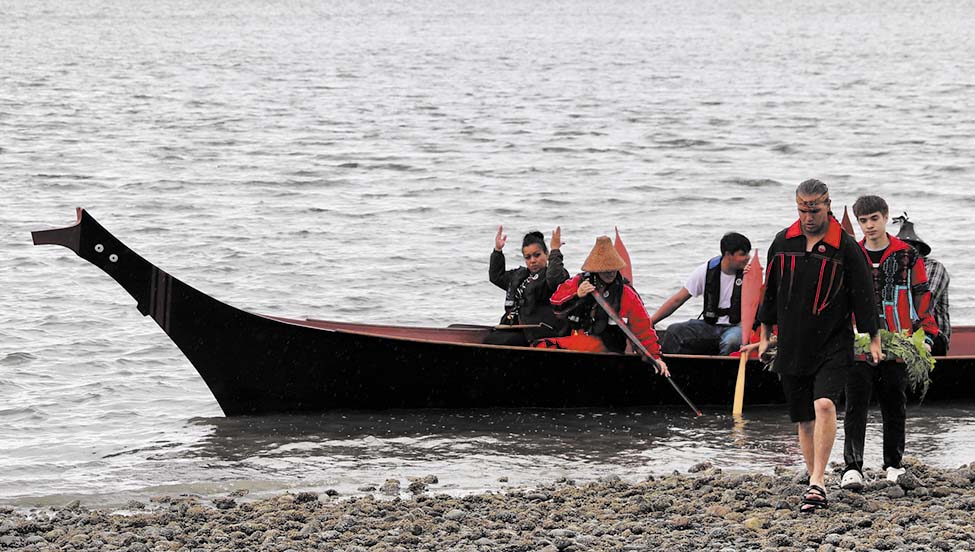
To really get an understanding of the significance of this ceremony and what it means to the Tulalip people, one must first delve into the Tribe’s history and learn of their stories passed through the generations. As you may know, salmon are integral to the Tulalip culture, diet, and tribal lifeways. Pre-contact, and prior to the current decline of the salmon population, this delicious source of nourishment swam through the Salish Sea, through local rivers and lakes, in abundance. The Tulalips have a traditional story that explains why the salmon returned each year in such great quantities. Back in 1993, Bernie ‘KyKy’ Gobin provided a fantastic retelling of the story Salmon Man, as told by Harriette Shelton-Dover, for the Marysville School District and it goes as follows:
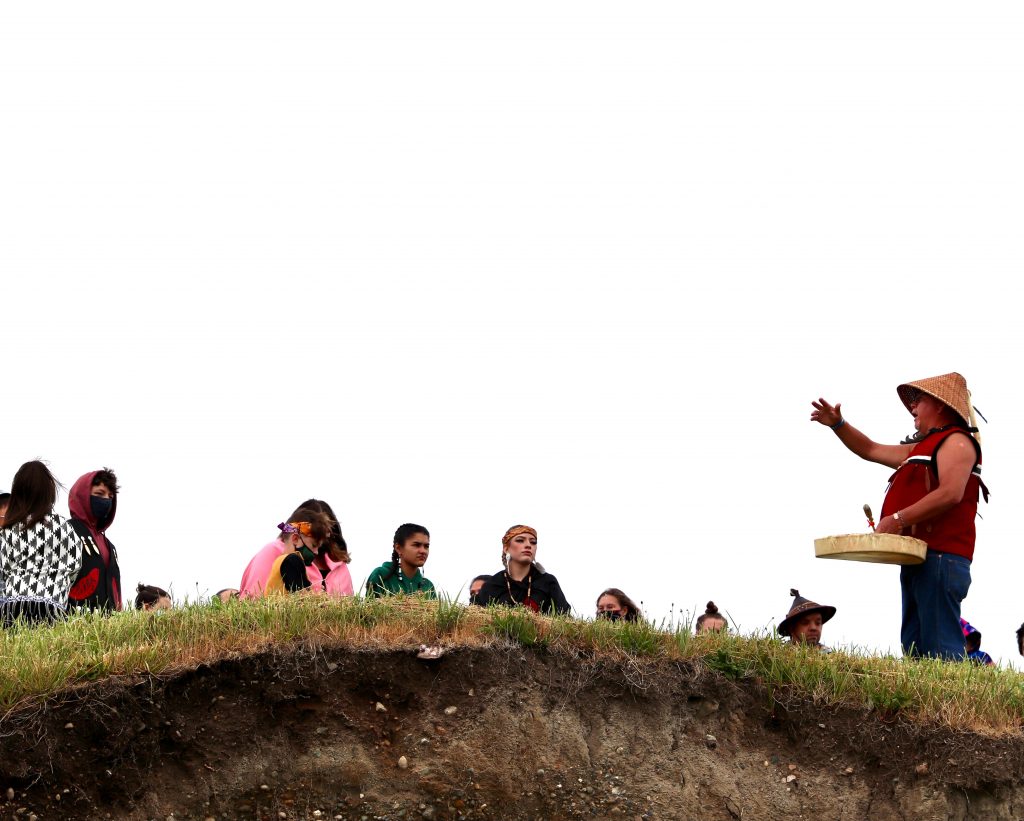
This is one version of the Salmon Man. You might have heard about the Tulalip Salmon Festival. The Salmon Festival was something that was practiced for hundreds of years by the Snohomish people, the sduhubš people. They are also called ‘the salmon people’. And the story’s extremely important because it links to the present day.
And the story goes that there is a tribe of Salmon People that live under the sea. And each year, they send out scouts to visit their homeland. And the way that the Snohomish people recognize that it’s time for the salmon scouts to be returning to their area is when, in the spring, a butterfly comes out. And the first person to see that butterfly will run, as fast as they can, to tell our chiefs or headmen or, now, they are called the chairman. One of the other ways they recognize that the salmon scouts are returning is when the wild spirea tree blooms. The people call it the ironwood tree, and that’s what they use for fish sticks and a lot of other important things, like halibut hooks. It’s a very hard wood. So, when they see either one of these, a tribal member will tell the chairman, and he immediately sends out word to the people and calls them together in the longhouse for a huge feast and celebration to give honor to the visitors that are coming.
The salmon scout will arrive out in the middle of Tulalip Bay there. And the people send out a canoe to meet him. And they put the salmon scout inside the canoe, where a cradle is filled with fern leaves and other soft leaves for a bed for him to come in on and keep him fresh. And he’ll come in by canoe to the cliff right below our longhouse, and, there, the whole tribe will be there on the water to greet him. And they’ll walk him in with songs of honor and just greet him in a special way. Then, he’ll be carried on that cradle up into the longhouse, where he’ll be taken around the fires three times and special songs will be sung in his honor. And they will show him the proper respect he needs as the high chief visitor from the Salmon people. And they will go through some different ceremonies there. Then, they will go up into what is now the tribal center, and prepare the feast. Before the feast, everyone will share in a tiny piece of the salmon and drink a glass of water with it, a little water.
That’s what is done. And then, everyone sits down and feasts and enjoys the salmon and visits with friends and neighbors.
At the end of feast, they get up. Maybe a speech will be made, and, hopefully, it won’t be too long. Then, a song is sung and they bring the remains that are left of the salmon back into the longhouse and thank him for coming and again honor him for the chief that he is and take him back down to the canoe, follow him back down there. And they take him back out and lay his remains back where they picked him up, out in the middle of Tulalip Bay. And, if they have treated that chief properly and showed him the proper respect, and treated him like the king he is, he’ll go back to the Salmon People that live under the sea and he’ll tell them that, “Hey, they greatly honored me. They treated me like I should have been treated. They gave me all the recognition I needed.” And he’ll recommend that the Salmon People return back in abundance.
And the reason to tell this story is because it concerns the environment. And to show that the Snohomish people practiced this for hundreds of years. They gave thanks for many things. One of the things was to honor this great chief from the Salmon People and try to protect his environment and have a place for him to come home to. It’s hard to imagine nowadays this visitor going back and telling them, “Hey, things are all right.” Because he has to tell them, “I’ve been up there, and I entered around Admiralty Head, and I started getting a headache.” And he says, “As I traveled further in I become confused and had a hard time finding Tulalip Bay this time.” And he says, “Worse than that. When I went up the Stillaguamish River my home was gone. Where I was born and raised, it’s not there.”
So, you know, it tells us something, that’s been told a long time: to conserve and keep things and honor all things because they’re alive. The trees are alive. Everything we eat was alive at some time. And we should give thanks and respect these things as living spirits and show them respect appropriately. And if we don’t, we’re going to lose everything as we know it today. The salmon are about gone. The forest is all but gone, and other resources are gone because of greed and mistreatment. We don’t know if we’ll ever be able to restore any of these things. So, this is an important story, the Salmon People story.*
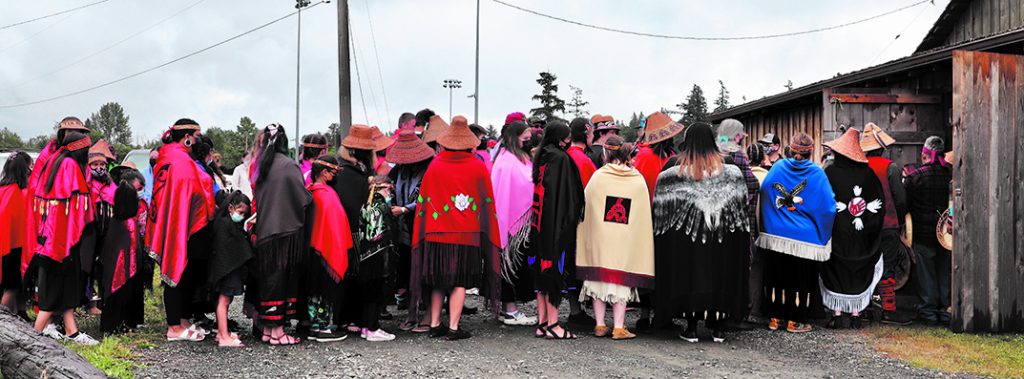
As Bernie mentioned, the Salmon Ceremony was actually practiced for hundreds of years pre-colonialism. During the assimilation era, all Indigenous traditions, ceremonies and even the use of traditional languages were outlawed by the US Government across the country. For several generations, there was no Salmon Ceremony celebration at Tulalip. That is, until 1976 when a group of elders, led by Harriette Shelton-Dover, brought the tradition back.
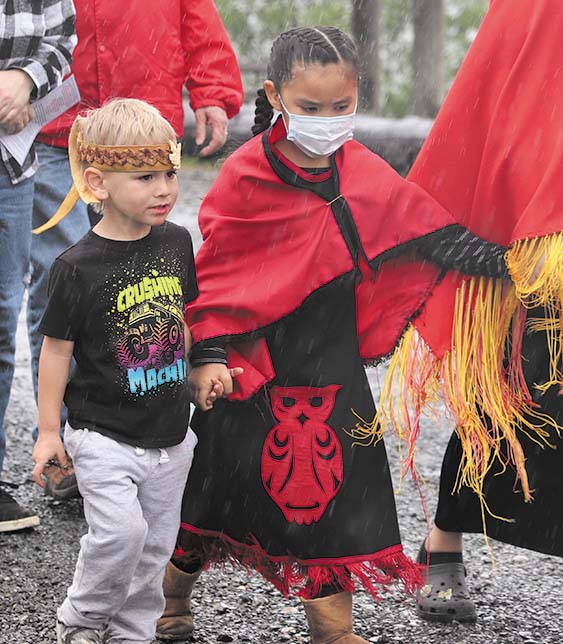
Said Tulalip Vice-Chairman Glen Gobin, “after the treaty signing and after the boarding school era, much of our teachings were taken away. We were not able to speak our languages. We were not able to live with our families. Much of what we had as a culture was disappearing quickly. Some of the elders remembered certain aspects and would share those memories of how things used to be. The elders in 1976, Harriette in particular, said we need to revive Salmon Ceremony, we need to bring it back. She gathered up different elders and they pieced together what each of them knew about the Salmon Ceremony from either things they personally witnessed or things they heard their grandparents talk about.”
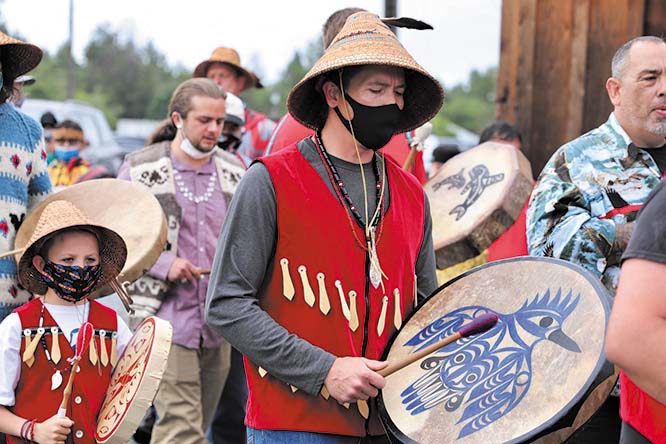
He continued, “Harriette always said that so much was taken from us and what we do today may not be exactly the same way it was done two hundred years ago. But as long as we do it with good intentions and with a pure heart, our elders will receive it in that manner. So, we hang on to those bits and pieces that we have and we’re thankful for them.”
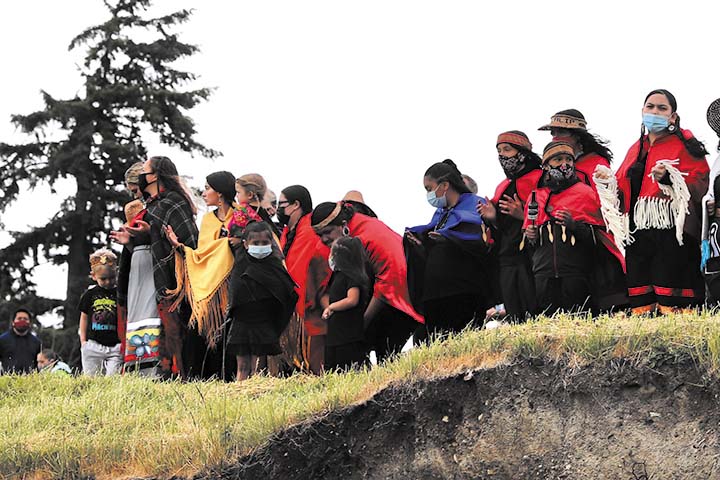
Ever since the revival, with the exception of 2020, the Tribe has turned out in large numbers, adorning cedar woven hats and headbands, traditional shawls, and beaded jewelry to welcome the guest of honor, the representative hailing from the underwater village. They sing passionately in the language of the ancestors, they keep time with elk and deer hide hand drums. They dance and feast in honor of the salmon people. And they keep the traditions and teachings of their own people alive and strong.
* Bates, Ann and Karen Bayne. 1993. Tulalip History and Culture: Supplemental Class Materials. Marysville: The Tulalip Tribes, Marysville School District, Catholic Community Services of Snohomish County. https://www.tulaliplearningjourney.org
By Micheal Rios, Tulalip News; photos by Matika Wilbur
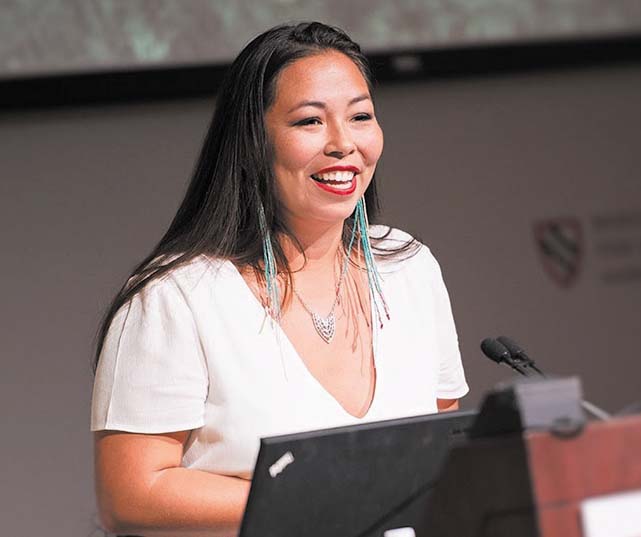
It’s been nearly a decade since Tulalip tribal member and celebrated visual storyteller Matika Wilbur made the bold decision to sell nearly everything she owned to begin an unprecedented journey of collecting the boundless beauty of Native American culture. Her journey is known as Project 562, a multi-year national photography project dedicated to photographing over 562 federally recognized tribes in the United States.
To unveil the true essence of contemporary Native issues and the magnitude of tradition, Matika travelled hundreds of thousands of miles, many in her RV dubbed ‘the Big Girl’, but also by horseback, train, plane, boat and on foot across all 48 continental states, Hawaii, deep into the Canadian tundra and into Alaska. The depths of her travels reflect her steadfast commitment to visit, engage, and photograph at least 562 federally recognized tribes, while also revealing her passion to inspire and educate.
“While teaching at Tulalip Heritage High School and attempting to create a photography curriculum with a narrative that our children deserve, I found an outdated narrative. It’s an incomplete story that perpetuates an American historical amnesia. It’s a story that’s romantic and dire…it’s the story of extinction,” she recalled of the circumstances that led to her life changing journey.
Matika points out the extinction theme often associated with Native America is easily perceived by doing a quick Google Images search. If you search for ‘African American’, ‘Hispanic American’ or ‘Asian American’, then you’ll find images of present day citizens who represent each culture. You’ll see proud, smiling faces and depictions of happy families. But if you search for ‘Native American’ the results are very different. You’ll see mostly black and white photos of centuries old, stoic Natives who are “leathered and feathered”.
“All of these images and misconceptions contribute to the collective consciousness of the American people, but more importantly it affects us in the ways that we imagine ourselves, in the ways we dream of possibility,” she explained.
And so began her multi-year mission to photograph and collect stories of contemporary Indigenous citizens from the hundreds of sovereign nations that make up Native America. As her photography portfolio continued to expand, so too did her realm of possibility.
Today, the now 37-year-old Matika has come to realize that Indigenous identity far surpasses federal acknowledgement. There are state-recognized tribes, urban and rural Native communities, and other spaces for Indigenous identity that don’t fall under the U.S. government’s recognition. Astonishingly, she estimates she has photographed close to 1,000 different tribal communities.
In a respectful way, Matika has been welcomed into one tribal community after another because they not only support her project whole-heartedly, but also because they desire to see things change. From media coverage to Google Images search results to what’s written in history books, Native Americans deserve an accurate portrayal of their vibrant, color-filled imagery and oral histories that have been passed down for generations.
Conversations about tribal sovereignty, self-determination, holistic wellness, historical trauma, decolonization of the mind, and revitalization of culture accompany the vast collection of photographs, videos, and audio recordings Matika has diligently collected. This creative, consciousness-shifting work will be widely distributed through national curricula, artistic publications, exhibitions, and online portals.
Melding powerful storytelling with video, photography and song, Matika expanded on her experiences photographing Native American women across the hundreds of sovereign nations she has visited for nearly a decade during her special guest appearance at the Mount Baker Theatre in Bellingham. Her captivating June 3rd presentation was at a social distanced max capacity. Upon concluding the audience showed their respect for the evening’s eye-opening and heartwarming cultural exchange with a loud standing ovation.
“So far I’ve had the opportunity to share my journey with audiences at museums, universities, conferences, and galleries across the United States,” stated Matika. “I strive to share stories and photographs of contemporary Indigenous people as the positive role models I know them to be.
“The most amazing part of the journey has been the generosity, kindness, and knowledge that Native people have offered me. I have met activists, educators, culture-bearers, artists, and students. The topics of their stories vary – from tribal sovereignty and self-determination, to recovery from historical trauma and revitalization of culture. They have transformed and inspired me, and I want to do my part to share their stories.”
Here are just a few of those riveting stories accompanied by stunning photos that were shared during Matika’s Mount Baker Theatre presentation – Seeds of Culture: The Portraits and Voices of Native American Women.
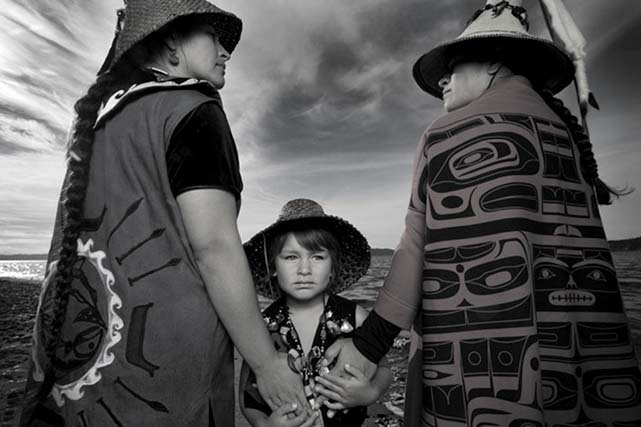
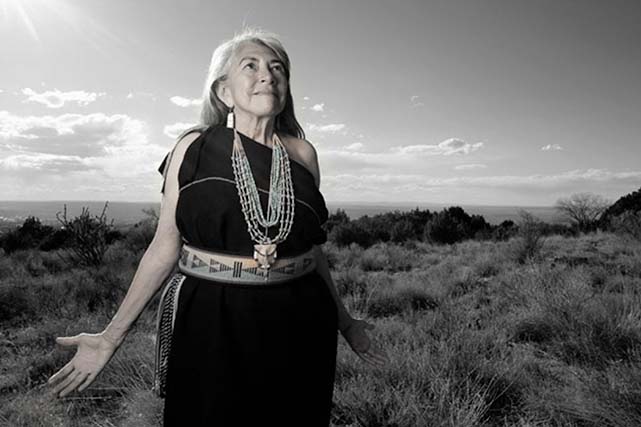
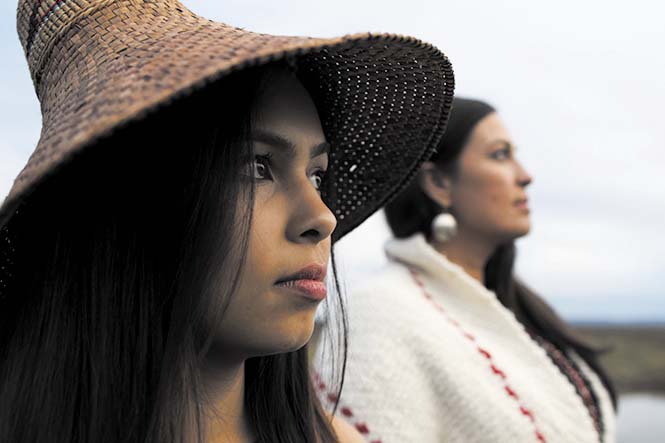
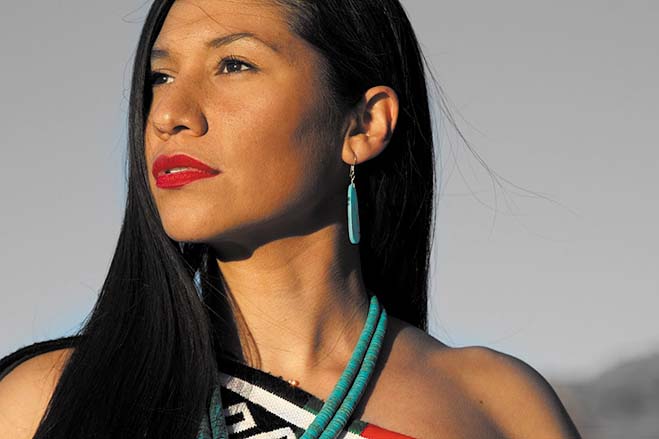
September 11, 1981 – June 5, 2021
It is with deep sadness and heavy hearts that we announce the passing of Warren Michael Moses, beloved son, grandson, father, brother, nephew and cousin. Warren went to be with our dear Lord on June 5, 2021 with his loving grandmother and mother by his side.
He was born on September 11, 1981 to Robert (Bebop) Moses Jr. and Kim Bustamante. Warren and his brothers were raised by his wonderful grandmother Johanna Moses and auntie in Tulalip after their father passed away. Warren was a Tulalip Tribal Member. He graduated from Marysville Pilchuck High School in 2000, and continued his education at Haskell University. He was very loving and sweet, a gentleman with a beautiful personality. He enjoyed playing and watching sports, especially his Seahawks. Warren was extremely gifted in music. He was the life of the party. He will be deeply missed by his family and friends. A star gone to soon.
He is preceded in death by his father, Robert (Bebop) Moses Jr.; grandfather, Robert Moses Sr.; Great Grandparents, Marya Jones Moses and Walter Moses Sr., Albert and Annie Moses. He leaves behind his son, Ira Moses-Snyder; grandmother, Johanna Moses; mother, Kim Bustamante; siblings, Athena Moses (Rob), Aimee Moses, Lorne Moses and Blake Moses; His nieces and nephews, Tianna Moses, Kiera Moses, D?sean Moses, Kathryn Elliott, Kohen, Kaine, KamBrea, Kendalyn and Kwynn Moses; Great niece Aaliyah-Camari Downing, former wife dear to his heart, Kimberly Moses along with her children, Austin Bercier, Marissa Bercier, Kaitlin Murray and Victoria Murray; and her grandchildren, Hunter Wilson and Lilliana Baker; Uncles, Jon Moses Sr, Anthony Moses Sr, Aaron Moses Sr, William Moses and most adored auntie Anna Moses; Uncles, Marvin, Benjamin, Allen Burchell; Aunt, Rachel Proper; as well as several cousins, friends, and family.
Funeral Service Friday, June 11, 2021 at 10:00 AM at the Tulalip Gathering Hall with burial to follow at Mission Beach Cemetery. Arrangements entrusted to Schaefer-Shipman Funeral Home.